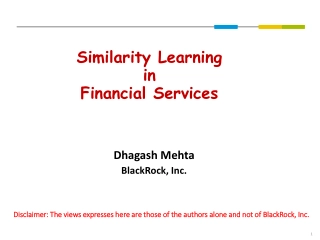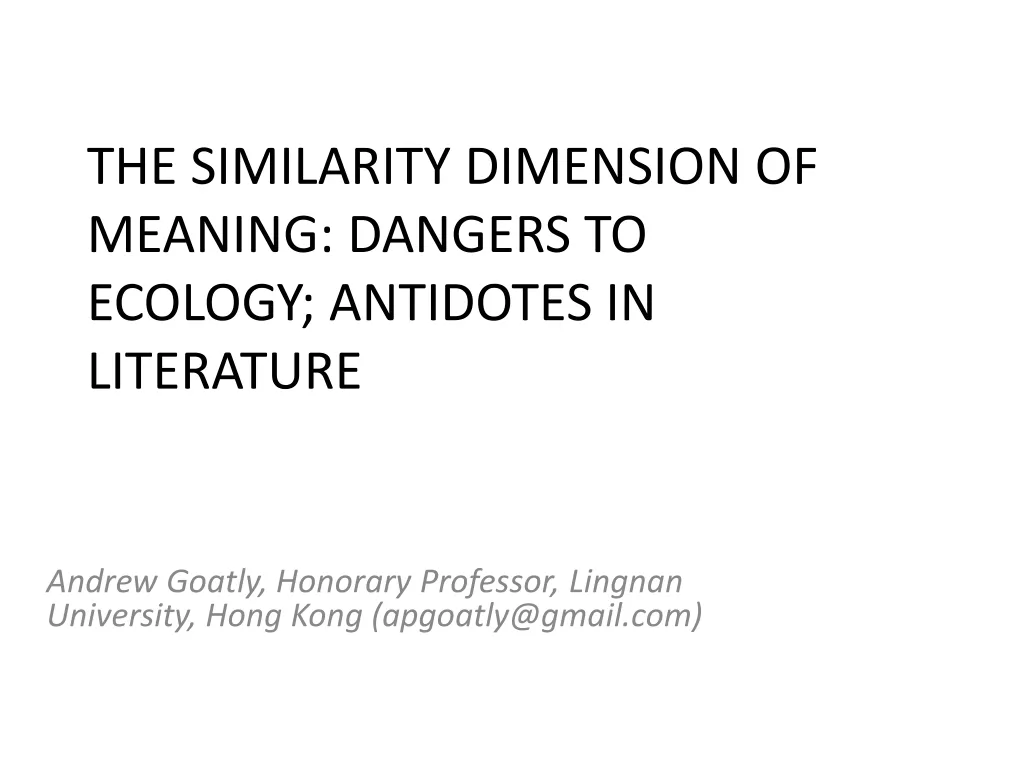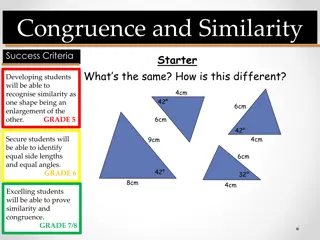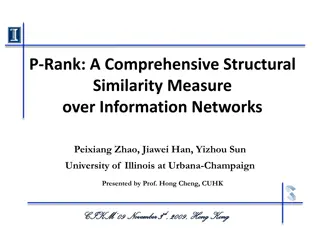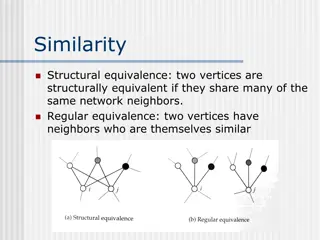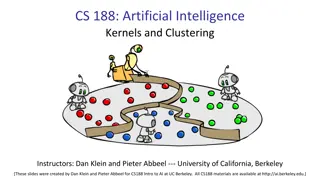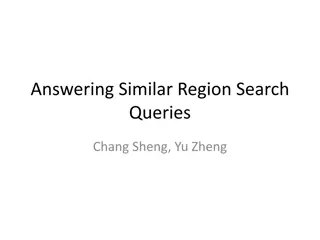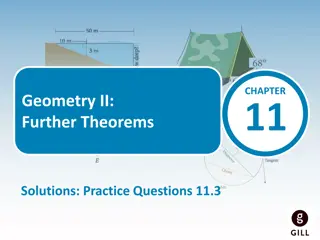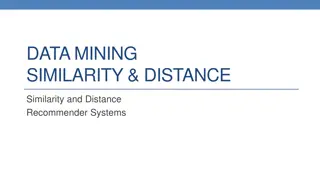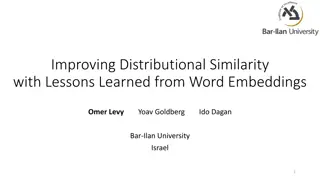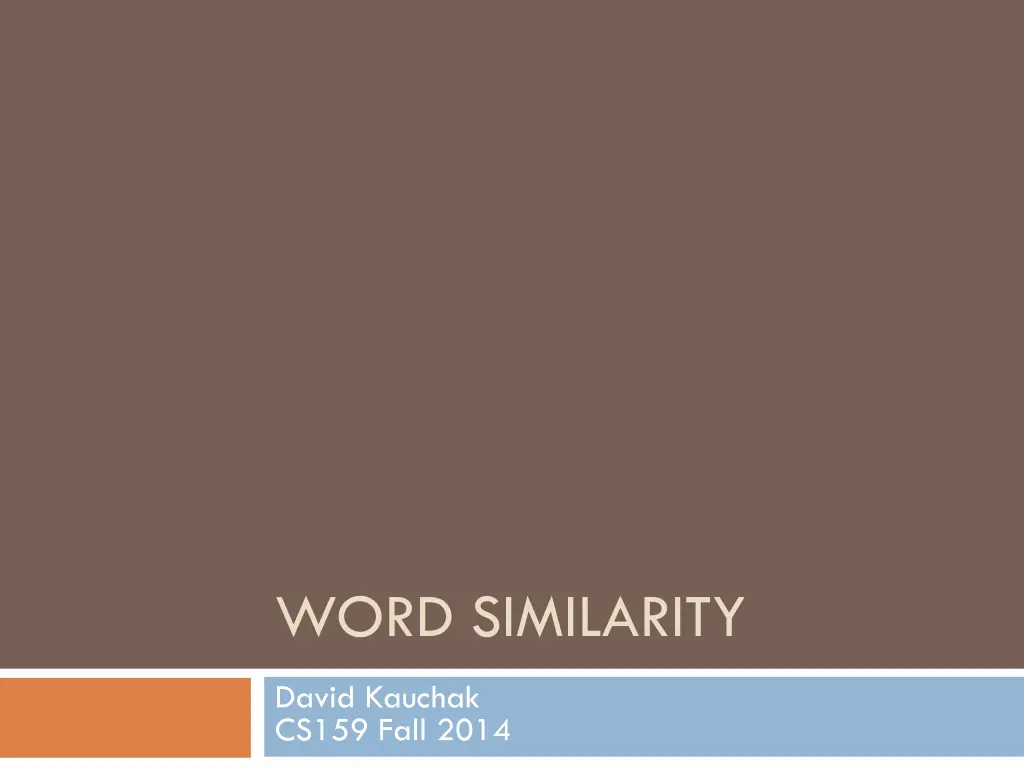
Text Similarity and Word Vector Calculations
Explore concepts in natural language processing including text similarity, bag of words representation, vector-based word calculations, normalized distance measures, and word importance weighting. Learn how to calculate similarity between texts based on multi-dimensional vectors and incorporate weights to enhance distance measures.
Download Presentation

Please find below an Image/Link to download the presentation.
The content on the website is provided AS IS for your information and personal use only. It may not be sold, licensed, or shared on other websites without obtaining consent from the author. If you encounter any issues during the download, it is possible that the publisher has removed the file from their server.
You are allowed to download the files provided on this website for personal or commercial use, subject to the condition that they are used lawfully. All files are the property of their respective owners.
The content on the website is provided AS IS for your information and personal use only. It may not be sold, licensed, or shared on other websites without obtaining consent from the author.
E N D
Presentation Transcript
WORD SIMILARITY David Kauchak CS159 Fall 2014
Admin Assignment 4 Quiz #2 Thursday Same rules as quiz #1 First 30 minutes of class Open book and notes Assignment 5 out on Thursday
Quiz #2 Topics Linguistics 101 Parsing Grammars, CFGs, PCFGs Top-down vs. bottom-up CKY algorithm Grammar learning Evaluation Improved models Text similarity Will also be covered on Quiz #3, though
Text Similarity A common question in NLP is how similar are texts ) = ? , sim( score: ? rank:
Bag of words representation For now, let s ignore word order: Obama said banana repeatedly last week on tv, banana, banana, banana Bag of words representation : multi-dimensional vector, one dimension per word in our vocabulary (4, 1, 1, 0, 0, 1, 0, 0, ) Frequency of word occurrence
Vector based word A a1: When a2: the a3: defendant a4: and a5: courthouse 1 2 1 1 0 Multi-dimensional vectors, one dimension per word in our vocabulary B b1: When b2: the b3: defendant b4: and b5: courthouse 1 2 1 0 1 How do we calculate the similarity based on these vectors?
Normalized distance measures Cosine n aibi n simcos(A,B) = A B = = i=1 a i b i i=1 n n 2 2 ai bi i=1 i=1 L2 n ( ai- bi)2 distL2(A,B)= i=1 L1 a and b are length normalized versions of the vectors n ai- bi distL1(A,B)= i=1
Our problems So far word order length synonym spelling mistakes word importance word frequency
Word importance Include a weight for each word/feature A w1 w2 w3 w4 w5 a1: When a2: the a3: defendant a4: and a5: courthouse 1 2 1 1 0 B w1 w2 w3 w4 w5 b1: When b2: the b3: defendant b4: and b5: courthouse 1 2 1 0 1
Distance + weights We can incorporate the weights into the distances Think of it as either (both work out the same): preprocessing the vectors by multiplying each dimension by the weight incorporating it directly into the similarity measure n n aibi n ai bi i=1 simcos(A,B)= A B= = i=1 n 2 2 ai bi i=1 i=1 n wiaiwibi = i=1 with weights n n (wiai)2 (wibi)2 i=1 i=1
Document vs. overall frequency The overall frequency of a word is the number of occurrences in a dataset, counting multiple occurrences Example: Word Overall frequency Document frequency insurance 10440 3997 try 10422 8760 Which word is a more informative (and should get a higher weight)?
Document frequency Word Collection frequency Document frequency insurance 10440 3997 try 10422 8760 Document frequency is often related to word importance, but we want an actual weight. Problems? n wiaiwibi simcos(A,B) = A B = i=1 n n (wiai)2 (wibi)2 i=1 i=1
From document frequency to weight Word Collection frequency Document frequency insurance 10440 3997 try 10422 8760 weight and document frequency are inversely related higher document frequency should have lower weight and vice versa document frequency is unbounded document frequency will change depending on the size of the data set (i.e. the number of documents)
Inverse document frequency idfw= log N # of documents in dataset dfw document frequency of w IDF is inversely correlated with DF higher DF results in lower IDF N incorporates a dataset dependent normalizer log dampens the overall weight
IDF example, suppose N=1 million word dfw idfw calpurnia 1 animal 100 sunday 1,000 fly 10,000 under 100,000 the 1,000,000 What are the IDFs assuming log base 10? idfw= log N dfw
IDF example, suppose N=1 million word dfw idfw calpurnia 1 6 animal 100 4 sunday 1,000 3 fly 10,000 2 under 100,000 1 the 1,000,000 0 There is one idf value/weight for each word idfw= log N dfw
IDF example, suppose N=1 million word dfw idfw calpurnia 1 animal 100 sunday 1,000 fly 10,000 under 100,000 the 1,000,000 What if we didn t use the log to dampen the weighting? idfw= log N dfw
IDF example, suppose N=1 million word dfw idfw calpurnia 1 1,000,000 animal 100 10,000 sunday 1,000 1,000 fly 10,000 100 under 100,000 10 the 1,000,000 1 Tends to overweight rare words!
TF-IDF One of the most common weighting schemes TF = term frequency IDF = inverse document frequency a i=ai logN/dfi IDF (word importance weight ) TF We can then use this with any of our similarity measures!
Stoplists: extreme weighting Some words like a and the will occur in almost every document IDF will be 0 for any word that occurs in all documents For words that occur in almost all of the documents, they will be nearly 0 A stoplist is a list of words that should not be considered (in this case, similarity calculations) Sometimes this is the n most frequent words Often, it s a list of a few hundred words manually created
Stoplist I a aboard about above across after afterwards against agin ago agreed-upon ah alas albeit all all-over almost along alongside altho although amid amidst among amongst an and another any anyone anything around as aside astride at atop avec away back be because before beforehand behind behynde below beneath beside besides between bewteen beyond bi both but by ca. de des despite do down due durin during each eh either en every ever everyone everything except far fer for from go goddamn goody gosh half have he hell her herself hey him himself his ho how If most of these end up with low weights anyway, why use a stoplist?
Stoplists Two main benefits More fine grained control: some words may not be frequent, but may not have any content value (alas, teh, gosh) Often does contain many frequent words, which can drastically reduce our storage and computation Any downsides to using a stoplist? For some applications, some stop words may be important
Our problems Which of these have we addressed? word order length synonym spelling mistakes word importance word frequency A model of word similarity!
Word overlap problems A: When the defendant and his lawyer walked into the court, some of the victim supporters turned their backs to him. B: When the defendant walked into the courthouse with his attorney, the crowd truned their backs on him.
Word similarity How similar are two words? w1 w2 w3 w ? sim(w1, w2) = ? rank: score: list: w1 and w2 are synonyms applications?
Word similarity applications General text similarity Thesaurus generation Automatic evaluation Text-to-text paraphrasing summarization machine translation information retrieval (search)
Word similarity How similar are two words? w1 w2 w3 w ? sim(w1, w2) = ? rank: score: list: w1 and w2 are synonyms ideas? useful resources?
Word similarity Four categories of approaches (maybe more) Character-based turned vs. truned cognates (night, nacht, nicht, natt, nat, noc, noch) Semantic web-based (e.g. WordNet) Dictionary-based Distributional similarity-based similar words occur in similar contexts
Character-based similarity sim(turned, truned) = ? How might we do this using only the words (i.e. no outside resources?
Edit distance (Levenshtein distance) The edit distance between w1 and w2 is the minimum number of operations to transform w1 into w2 Operations: insertion deletion substitution EDIT(turned, truned) = ? EDIT(computer, commuter) = ? EDIT(banana, apple) = ? EDIT(wombat, worcester) = ?
Edit distance EDIT(turned, truned) = 2 delete u insert u EDIT(computer, commuter) = 1 replace p with m EDIT(banana, apple) = 5 delete b replace n with p replace a with p replace n with l replace a with e EDIT(wombat, worcester) = 6
Better edit distance Are all operations equally likely? No Improvement, give different weights to different operations replacing a for e is more likely than z for y Ideas for weightings? Learn from actual data (known typos, known similar words) Intuitions: phonetics Intuitions: keyboard configuration
Vector character-based word similarity sim(turned, truned) = ? Any way to leverage our vector-based similarity approaches from last time?
Vector character-based word similarity sim(turned, truned) = ? Generate a feature vector based on the characters (or could also use the set based measures at the character level) a: 0 b: 0 c: d: 1 e: 1 f: g: 0 a: 0 b: 0 c: d: 1 e: 1 f: g: 0 0 0 0 0 problems?
Vector character-based word similarity sim(restful, fluster) = ? Character level loses a lot of information a: 0 b: 0 c: d: 1 e: 1 f: g: 0 a: 0 b: 0 c: d: 1 e: 1 f: g: 0 0 0 0 0 ideas?
Vector character-based word similarity sim(restful, fluster) = ? Use character bigrams or even trigrams aa: 0 ab: 0 ac: 0 es: 1 fu: 1 re: 1 aa: 0 ab: 0 ac: 0 er: 1 fl: 1 lu: 1
Word similarity Four general categories Character-based turned vs. truned cognates (night, nacht, nicht, natt, nat, noc, noch) Semantic web-based (e.g. WordNet) Dictionary-based Distributional similarity-based similar words occur in similar contexts
WordNet Lexical database for English 155,287 words 206,941 word senses 117,659 synsets (synonym sets) ~400K relations between senses Parts of speech: nouns, verbs, adjectives, adverbs Word graph, with word senses as nodes and edges as relationships Psycholinguistics WN attempts to model human lexical memory Design based on psychological testing Created by researchers at Princeton http://wordnet.princeton.edu/ Lots of programmatic interfaces
WordNet relations synonym antonym hypernyms hyponyms holonym meronym troponym entailment (and a few others)
WordNet relations synonym X and Y have similar meaning antonym X and Y have opposite meanings hypernyms subclass beagle is a hypernym of dog hyponyms superclass dog is a hyponym of beagle holonym contains part car is a holonym of wheel meronym part of wheel is a meronym of car
WordNet relations troponym for verbs, a more specific way of doing an action run is a troponym of move dice is a troponym of cut entailment for verbs, one activity leads to the next sleep is entailed by snore (and a few others)
WordNet Graph, where nodes are words and edges are relationships There is some hierarchical information, for example with hyp-er/o-nomy
WordNet-like Hierarchy animal fish mammal reptile amphibian horse cat wolf dog mare stallion hunting dog dachshund terrier To utilize WordNet, we often want to think about some graph- based measure.
WordNet-like Hierarchy animal fish mammal reptile amphibian horse cat wolf dog mare stallion hunting dog dachshund terrier Rank the following based on similarity: SIM(wolf, dog) SIM(wolf, amphibian) SIM(terrier, wolf) SIM(dachshund, terrier)
WordNet-like Hierarchy animal fish mammal reptile amphibian horse cat wolf dog SIM(dachshund, terrier) SIM(wolf, dog) SIM(terrier, wolf) SIM(wolf, amphibian) mare stallion hunting dog dachshund terrier What information/heuristics did you use to rank these?
WordNet-like Hierarchy animal fish mammal reptile amphibian horse cat wolf dog SIM(dachshund, terrier) SIM(wolf, dog) SIM(terrier, wolf) SIM(wolf, amphibian) mare stallion hunting dog dachshund terrier - path length is important (but not the only thing) - words that share the same ancestor are related - words lower down in the hierarchy are finer grained and therefore closer
WordNet similarity measures path length doesn t work very well Some ideas: path length scaled by the depth (Leacock and Chodorow, 1998) With a little cheating: Measure the information content of a word using a corpus: how specific is a word? words higher up tend to have less information content more frequent words (and ancestors of more frequent words) tend to have less information content
WordNet similarity measures Utilizing information content: information content of the lowest common parent (Resnik, 1995) information content of the words minus information content of the lowest common parent (Jiang and Conrath, 1997) information content of the lowest common parent divided by the information content of the words (Lin, 1998)

